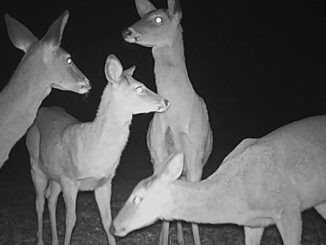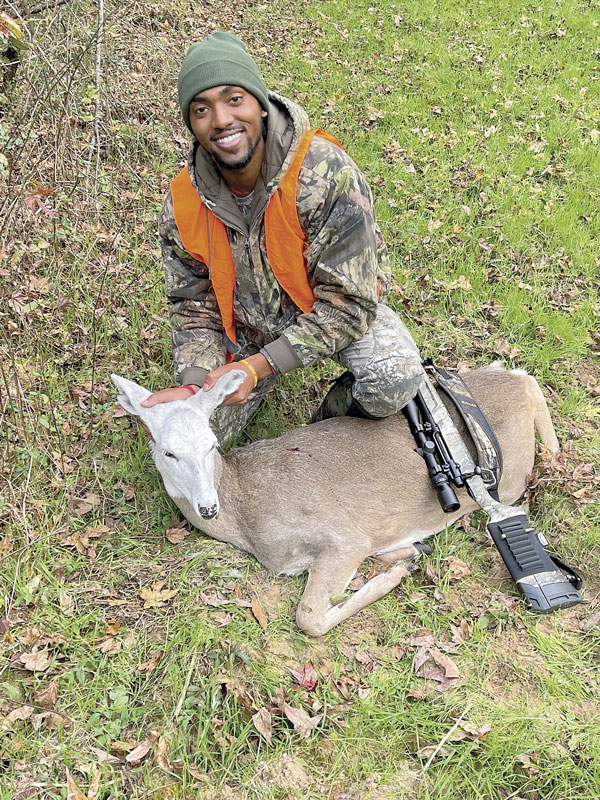
It seems like the 2021-2022 deer season produced more than its fair share of abnormal looking deer in the Louisiana Sportsman circle of deer hunters.
And here we are getting close to yet another season for hunting whitetails in Louisiana.
Last season, bucks with palmated antlers, cactus bucks and velvet bucks were harvested by deer hunters who reported these strange deer to the magazine staff. Also harvested were piebald deer and deer with ivory hooves. There was even a “unicorn” deer.
While many weird things are showing up these days, I don’t think the Covid pandemic or climate change can be blamed as the cause of this. Genetics is the common explanation for some of these anomalies. Accidents can explain some of the other weird findings.
Anomalies can show up at any time, but for the most part, they are uncommon or even rare. Disease issues can also be the cause for a strange looking deer. I remember receiving a photo of a deer that had a large tumor on its brisket area that made it appear as if it had swallowed a basketball. Deer with a mouth that looks as if it has a baseball on one side of its jaw is an animal suffering from a food impaction, known as lumpy jaw, and is caused by an arterial worm.
LDWF has a wildlife disease unit with wildlife veterinarians who are always interested in hearing about your strange findings so don’t hesitate to contact your local biologists and ask them about abnormal looking deer.
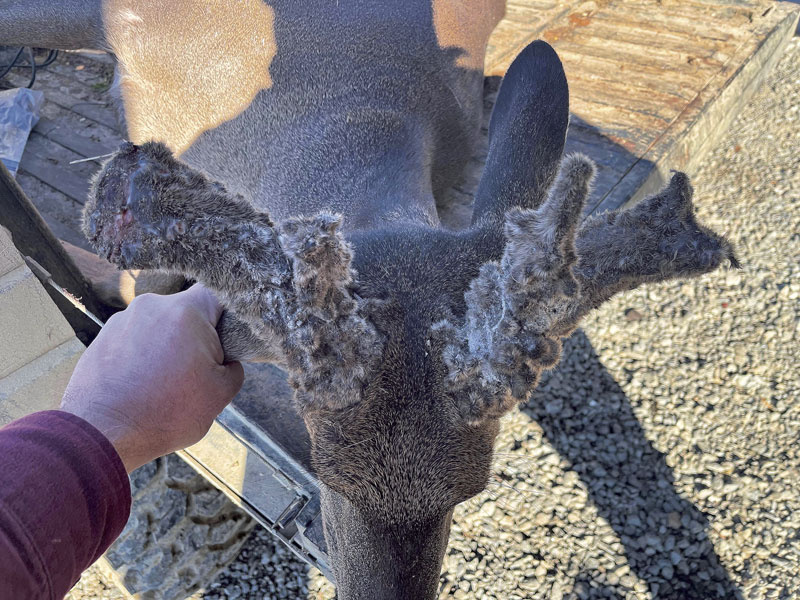
Abnormal antlers
Antlers are a bucks crowning glory, so I will begin my discussion with them. The Boone and Crockett and Pope and Young scoring systems were designed to score deer with Typical antlers. When the scoring began, it was soon evident that some deer develop abnormal antler growth, so a Non-Typical antler category was developed to document these deer, since they are entirely different from bucks with typical antlers.
Non-Typical antlers do occur in the wild in Louisiana, but are not as common as bucks with typical antlers, but they always attract attention! Really large freaky looking non-typical racks are common on game farms where they are managed to produce these antlers. Non-typical racks can be a result of genetics and heredity. Some non-typical growth is due to accidents that damage the pedicel, the bone that the antlers grow on, or when the buck is in velvet and growing antlers are damaged. Fences, vehicles, downed timber and much more can cut or break the growing bone resulting in a rack with abnormal growth.
There is documentation of adult bucks in Louisiana that never grew antlers. This problem generally occurs during the early embryonic stages of development and the pedicel bone for whatever reason, never develops and the buck will never grow antlers. It is often associated with intense flooding on the habitat and the does are over-stressed from it.
The reverse of this is a doe that has antlers. During my outdoor career I have only seen this two or three times. Usually the antler development is small but I am aware of one doe that produced a rack with eight points. While such cases are rare, it does happen. Generally the doe is fertile and still can produce fawns. Does with antlers are caused by abnormally high levels of testosterone in her system.
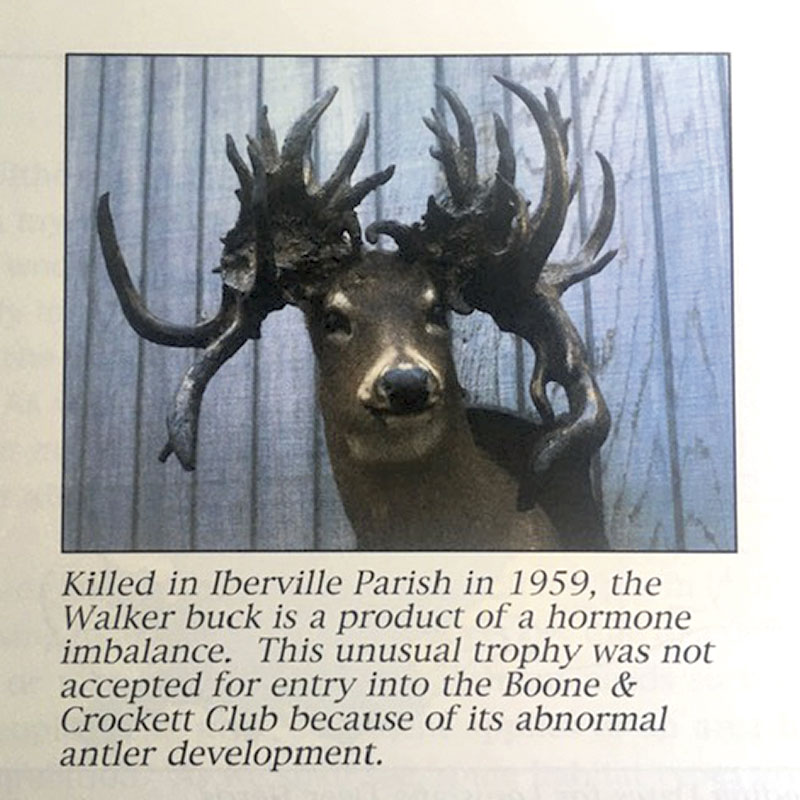
Bucks can also have higher than normal levels of testosterone and produce really abnormal antler growth. The Sammy Walker Buck is probably the most famous of Louisiana bucks with this condition. The Walker Buck had an abnormal hormone imbalance and produced a very large non-typical rack. Because of the hormone imbalance the buck was not accepted for entry into the Boone and Crockett scoring system.
Bucks with palmated antlers that appear moose-like in appearance show up periodically. Jackie Hay killed a fine palmated specimen in East Feliciana Parish last season. I was blessed to have killed one years ago but not as large as Hay’s buck. Such antler growth is a result of genetics and may show up in other bucks in future seasons.
You may have heard the term cactus buck at the hunting camp. These are really strange looking racks that somewhat look like a mass of coral or desert cactus with a bunch of knob-like velvet structures. These bucks have experienced testicle problems of some sort and do not produce testosterone which regulates antler growth. The antlers on the buck are never shed and always stay in velvet; winter freezes will damage the soft antler material, creating this strange look. Scott Cobb killed such a buck last season. It could be considered a true textbook cactus buck.
Chris Fontenot killed a nice Basin buck on January 4, 2022 that was still in velvet. The tarsal glands were black, an indication that it had been working scrapes and it was chasing a doe, so I would assume its testosterone level was ok. There were some strange things happening in the woods following Hurricane Ida last year and this could be just one of them. I would classify this as a velvet buck and not a cactus buck. Generally velvet bucks are killed during the early archery season, before the velvet is shed.

Pelage coloration
Hunters should be familiar with the reddish-brown coloration of deer in the summer. This summer coat is shed in the fall and replaced with the brownish-gray winter hair. The thick winter coat provides good insulation for the deer during cold winter weather.
True albino deer are rare. These deer are white, have pink eyes and grayish hooves. There is a deer herd on the Seneca Army Depot in New York that has a large herd of white deer. These deer were protected and the end result was a large herd of white deer. A white deer that is not a true albino will have brown eyes and is referred to as a leucistic deer. The condition of albinism is a recessive genetic trait. Protecting such deer will increase the chances of inbreeding, thereby increasing the number of such deer. My friend Scott Durham had a few pictures of an albino deer that was on his property near Liberty, Miss., and this is the only wild albino I know of.
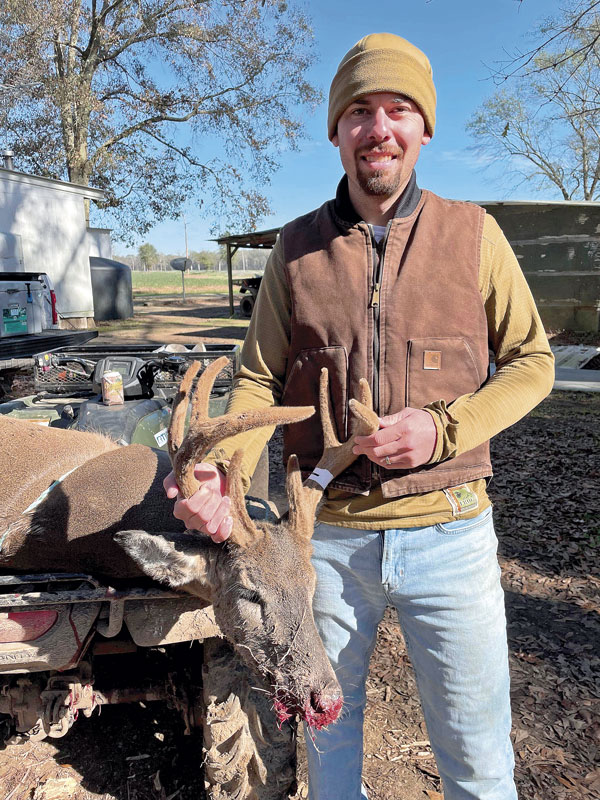
The opposite of a white deer would be a melanistic deer, one that has very high levels of the melanism pigment. These black deer are extremely rare and I have never seen one. When LDWF managed the Jackson-Bienville WMA, there were deer that would be brought to the check station that had a dark black line that ran from the head to the tail. It made for an attractive hide and no doubt was a result of genetics.
A piebald deer, one that is both brown and white, the degree of color splotches can greatly vary, is more common than an albino deer, but the frequency that it occurs is still low. I was hunting years ago on a tract of land in East Feliciana Parish during the early bow season. I saw something that was brown and white coming down a ridge toward me and my first thought was “what is a goat doing out here?” It was a piebald fawn that stopped out in front of me and was shortly joined by its normal colored sibling. Then the normal colored doe arrived.
That’s the only live piebald deer I have seen. A few years later, a piebald buck was killed on this property and I have no doubt it was the fawn I saw. This is unusual because the general thought is that most of these white colored deer stand out so much that they are easy prey for predators. I have over the years received several photos of hunters who have killed piebald deer.
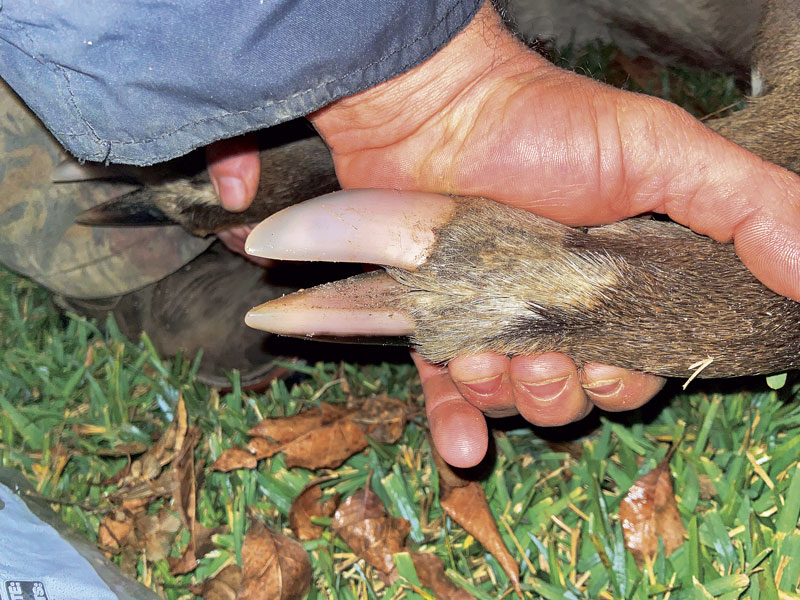
Sometimes this lack of melanism, black coloration, will affect the hooves of deer. I killed a doe one year in West Feliciana with white hooves on one front leg. Brent Robertson killed a nice 9-point buck in Mississippi last season that had what he referred to as ivory hooves. These would certainly make for an interesting key chain or ornament of some type.
Often times these deer will have a Roman Nose, a condition where the bridge of the nose is bent upward. I have killed some runty bucks that have had this condition. Another strange condition that deer can have is an anomaly of the lower jaw known as brachygnathia, shortness of the lower jaw giving the deer the look of having an overbite. The first real racked buck I ever killed was 4 ½ years old and had this condition!
As I stated at the beginning, LDWF can help you understand or explain strange looking deer so don’t hesitate to contact them. Also be aware of the CWD issue and work with the department on this serious problem. Be safe and always share your success with those that have needs.
